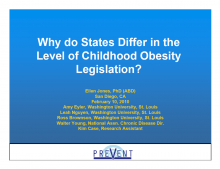We are pleased to announce an exciting new alliance between Active Living Research and GP RED to co-host and coordinate...
Why Do States Differ in the Level of Childhood Obesity Legislation?

Presentation at the 2010 Active Living Research Annual Conference
Background:
Childhood obesity in the United States has reached epidemic proportions. In response, there has been a focus on identifying effective policy interventions and prevention strategies to reverse this epidemic by 2015. In recent years, states have introduced and adopted legislation that focuses on obesity prevention in youth in both school and community settings. However, states differ in both the quantity and quality of this legislation.
Objectives:
The objective of this study is to examine qualitative factors that influence the passage of childhood obesity legislation in states with both moderate and highest rates of childhood obesity.
Methods:
In order to identify states with different levels of childhood obesity policy action, legislation on sixteen evidence based topic areas was analyzed. The topic areas included nutrition and vending standards, health and PE credit, BMI reporting, safe routes to school, local authority, model school policies, taskforces, farmer’s markets, farm to school programs, walking and biking trails, menu and product labeling, soda and snack taxes, and childcare physical activity and nutrition standards. States were given a score based on the total number of bills enacted within these categories, and identified as low policy action states or high policy action states. The states were also ranked by child and adolescent obesity rates. Twelve states were chosen to represent both high policy action and low policy action and high and moderate childhood obesity states. Legislative key informants from each state were interviewed by phone on childhood obesity. The interviews were transcribed, coded and analyzed.
Results:
Two or three phone interviews were conducted in each of the twelve states with legislators or legislative staff. Legislators and staffers from all states expressed some concern for childhood obesity in varying levels. Overall, legislators were divided in their perceptions of causes of obesity and likelihood of successful policy interventions. Legislative perception varied among states with high and low policy action. Contextual factors including public support, legislator factors and type of legislature contributed to differences.
Conclusion:
Understanding the policy process is an essential step in enacting evidence-based interventions that may prevent childhood obesity and improve health. This study adds a qualitative component to current analysis of state obesity policy through interviews with state legislators and staff. Understanding the wide range of states’ experience in obesity policy identified facilitators and barriers to enactment of childhood obesity legislation. Both non-modifiable (legislative factors and legislator factors) and modifiable factors (bill content, bill context, and public support) must be considered. Results provide a more robust understanding of state level policy interventions to improve public health.
Support:
This project is funded by a grant from the Robert Wood Johnson Foundation’s Active Living Research Program (#65559).
STAY UP TO DATE
RECENTLY ADDED TOOLS & RESOURCES
MOVE! A BLOG ABOUT ACTIVE LIVING
The "Active Living Conference" aims to break down research and practice silos and...







